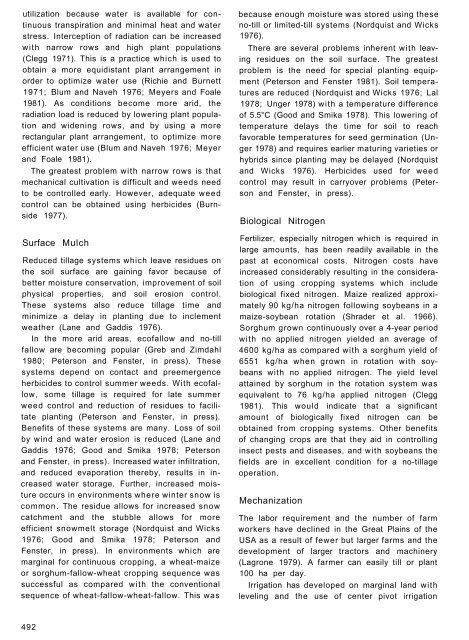RA 00048.pdf - OAR@ICRISAT
RA 00048.pdf - OAR@ICRISAT
RA 00048.pdf - OAR@ICRISAT
Create successful ePaper yourself
Turn your PDF publications into a flip-book with our unique Google optimized e-Paper software.
utilization because water is available for continuous<br />
transpiration and minimal heat and water<br />
stress. Interception of radiation can be increased<br />
with narrow rows and high plant populations<br />
(Clegg 1971). This is a practice which is used to<br />
obtain a more equidistant plant arrangement in<br />
order to optimize water use (Richie and Burnett<br />
1971; Blum and Naveh 1976; Meyers and Foale<br />
1981). As conditions become more arid, the<br />
radiation load is reduced by lowering plant population<br />
and widening rows, and by using a more<br />
rectangular plant arrangement, to optimize more<br />
efficient water use (Blum and Naveh 1976; Meyer<br />
and Foale 1981).<br />
The greatest problem with narrow rows is that<br />
mechanical cultivation is difficult and weeds need<br />
to be controlled early. However, adequate weed<br />
control can be obtained using herbicides (Burnside<br />
1977).<br />
Surface Mulch<br />
Reduced tillage systems which leave residues on<br />
the soil surface are gaining favor because of<br />
better moisture conservation, improvement of soil<br />
physical properties, and soil erosion control.<br />
These systems also reduce tillage time and<br />
minimize a delay in planting due to inclement<br />
weather (Lane and Gaddis 1976).<br />
In the more arid areas, ecofallow and no-till<br />
fallow are becoming popular (Greb and Zimdahl<br />
1980; Peterson and Fenster, in press). These<br />
systems depend on contact and preemergence<br />
herbicides to control summer weeds. With ecofallow,<br />
some tillage is required for late summer<br />
weed control and reduction of residues to facilitate<br />
planting (Peterson and Fenster, in press).<br />
Benefits of these systems are many. Loss of soil<br />
by wind and water erosion is reduced (Lane and<br />
Gaddis 1976; Good and Smika 1978; Peterson<br />
and Fenster, in press). Increased water infiltration,<br />
and reduced evaporation thereby, results in increased<br />
water storage. Further, increased moisture<br />
occurs in environments where winter snow is<br />
common. The residue allows for increased snow<br />
catchment and the stubble allows for more<br />
efficient snowmelt storage (Nordquist and Wicks<br />
1976; Good and Smika 1978; Peterson and<br />
Fenster, in press). In environments which are<br />
marginal for continuous cropping, a wheat-maize<br />
or sorghum-fallow-wheat cropping sequence was<br />
successful as compared with the conventional<br />
sequence of wheat-fallow-wheat-fallow. This was<br />
because enough moisture was stored using these<br />
no-till or limited-till systems (Nordquist and Wicks<br />
1976).<br />
There are several problems inherent with leaving<br />
residues on the soil surface. The greatest<br />
problem is the need for special planting equipment<br />
(Peterson and Fenster 1981). Soil temperatures<br />
are reduced (Nordquist and Wicks 1976; Lal<br />
1978; Unger 1978) with a temperature difference<br />
of 5.5°C (Good and Smika 1978). This lowering of<br />
temperature delays the time for soil to reach<br />
favorable temperatures for seed germination (Unger<br />
1978) and requires earlier maturing varieties or<br />
hybrids since planting may be delayed (Nordquist<br />
and Wicks 1976). Herbicides used for weed<br />
control may result in carryover problems (Peterson<br />
and Fenster, in press).<br />
Biological Nitrogen<br />
Fertilizer, especially nitrogen which is required in<br />
large amounts, has been readily available in the<br />
past at economical costs. Nitrogen costs have<br />
increased considerably resulting in the consideration<br />
of using cropping systems which include<br />
biological fixed nitrogen. Maize realized approximately<br />
90 kg/ha nitrogen following soybeans in a<br />
maize-soybean rotation (Shrader et al. 1966).<br />
Sorghum grown continuously over a 4-year period<br />
with no applied nitrogen yielded an average of<br />
4600 kg/ha as compared with a sorghum yield of<br />
6551 kg/ha when grown in rotation with soybeans<br />
with no applied nitrogen. The yield level<br />
attained by sorghum in the rotation system was<br />
equivalent to 76 kg/ha applied nitrogen (Clegg<br />
1981). This would indicate that a significant<br />
amount of biologically fixed nitrogen can be<br />
obtained from cropping systems. Other benefits<br />
of changing crops are that they aid in controlling<br />
insect pests and diseases, and with soybeans the<br />
fields are in excellent condition for a no-tillage<br />
operation.<br />
Mechanization<br />
The labor requirement and the number of farm<br />
workers have declined in the Great Plains of the<br />
USA as a result of fewer but larger farms and the<br />
development of larger tractors and machinery<br />
(Lagrone 1979). A farmer can easily till or plant<br />
100 ha per day.<br />
Irrigation has developed on marginal land with<br />
leveling and the use of center pivot irrigation<br />
492

















